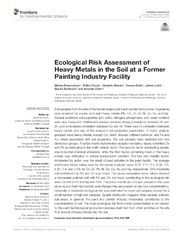Приказ основних података о документу
Ecological Risk Assessment of Heavy Metals in the Soil at a Former Painting Industry Facility
| dc.creator | Radomirović, Milena | |
| dc.creator | Ćirović, Željko | |
| dc.creator | Maksin, Danijela | |
| dc.creator | Bakić, Tamara | |
| dc.creator | Lukić, Jelena | |
| dc.creator | Stanković, Slavka | |
| dc.creator | Onjia, Antonije | |
| dc.date.accessioned | 2021-03-10T14:13:44Z | |
| dc.date.available | 2021-03-10T14:13:44Z | |
| dc.date.issued | 2020 | |
| dc.identifier.issn | 2296-665X | |
| dc.identifier.uri | http://TechnoRep.tmf.bg.ac.rs/handle/123456789/4357 | |
| dc.description.abstract | Soil samples from the site of the former largest paint and varnish factory in ex-Yugoslavia were analyzed for arsenic and eight heavy metals (Pb, Cd, Zn, Cr, Ni, Cu, Fe, and Hg). Several additional soil properties (pH, sulfur, nitrogen, phosphorus, and water content) were also measured. Multivariate analysis showed strong correlations between Pb and Zn; and a moderate correlation between Cu and Ni. There was no correlation between heavy metals and any of the analyzed soil properties parameters. A factor analysis grouped most heavy metals, except Cd, which showed different behavior, and Fe and As, which associated with soil properties. The soil samples were clustered into two distinctive groups. Positive matrix factorization receptor modeling clearly identified Zn and Pb as belonging to the traffic vehicle factor. The second factor dominating arsenic was industrial chemical emissions, while the third factor containing most of the heavy metals was attributed to natural background variation. The last non-metallic factor, dominated by sulfur, was the result of past activities in the paint facility. The average enrichment factor values were for the metals analyzed were: 0.73; 0.71; 2.4; 0.58; 2.3; 0.87; 1.6; and 0.76; for Cr, Cd, Pb, Ni, Zn, Cu, As, and Hg, respectively. Only moderate soil enrichment by Pb and Zn was found. The geoaccumulation index values showed a moderately polluted soil with Pb and Zn, but most contributing to the ecological risk were Cd with 63% and Hg with 19%. These two metals are of major concern in this case study due to their high toxicity, even though they are present at very low concentrations. Generally, a moderate ecological risk was estimated for most soil samples, except for a small number of high-risk samples. Spatial distribution mapped three severely polluted sub-areas. In general, the paint and varnish industry moderately contributes to the contamination of soil. The main ecological risk from metal contamination is not related to the paint technological production process itself, but from other activities at the site that deposit of heavy metals into the soil. | en |
| dc.publisher | Frontiers Media Sa, Lausanne | |
| dc.relation | info:eu-repo/grantAgreement/MESTD/inst-2020/200135/RS// | |
| dc.rights | openAccess | |
| dc.rights.uri | https://creativecommons.org/licenses/by/4.0/ | |
| dc.source | Frontiers in Environmental Science | |
| dc.subject | trace elements | en |
| dc.subject | enrichment | en |
| dc.subject | geoaccumulation | en |
| dc.subject | PCA | en |
| dc.subject | GIS | en |
| dc.subject | PMF | en |
| dc.title | Ecological Risk Assessment of Heavy Metals in the Soil at a Former Painting Industry Facility | en |
| dc.type | article | |
| dc.rights.license | BY | |
| dc.citation.other | 8: - | |
| dc.citation.rank | M21 | |
| dc.citation.volume | 8 | |
| dc.identifier.doi | 10.3389/fenvs.2020.560415 | |
| dc.identifier.fulltext | http://TechnoRep.tmf.bg.ac.rs/bitstream/id/1984/4354.pdf | |
| dc.identifier.scopus | 2-s2.0-85092502963 | |
| dc.identifier.wos | 000576234500001 | |
| dc.type.version | publishedVersion |

